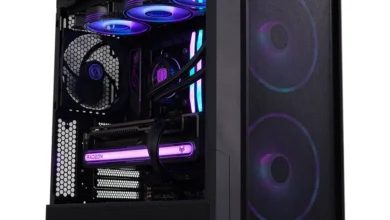How to Build a Gaming PC Under $1000: A Comprehensive Guide

Building your own gaming PC under $1000 is a rewarding experience that combines cost-effectiveness with the ability to customize your system to meet your specific gaming needs. Whether you’re a first-time builder or a seasoned enthusiast, crafting a PC at this price point ensures you get great performance without breaking the bank. In this guide, we’ll outline the components you’ll need, tips for assembly, and answer common questions. By the end, you’ll have all the information you need to build a gaming PC under $1000.
Why Build a Gaming PC Under $1000?
Building a gaming PC under $1000 strikes the perfect balance between performance and budget. It allows gamers to enjoy high-quality graphics and smooth gameplay without overspending. Prebuilt systems in this price range often include lower-quality components to keep costs down. By building your own, you get better control over the quality and compatibility of your parts.
Recommended Components for a Gaming PC Under $1000
Here’s a breakdown of components for a budget-friendly gaming PC. Prices may vary, so look for sales or discounts to stay within budget.
| Component | Recommended Part | Approx. Price |
|---|---|---|
| Processor (CPU) | AMD Ryzen 5 5600X | $190 |
| Graphics Card (GPU) | NVIDIA GeForce RTX 3060 | $300 |
| Motherboard | MSI B550-A PRO | $120 |
| Memory (RAM) | Corsair Vengeance LPX 16GB (2x8GB) 3200MHz | $60 |
| Storage | Western Digital Blue 1TB NVMe SSD | $50 |
| Power Supply (PSU) | EVGA 600 W1 600W 80+ White | $45 |
| Case | NZXT H510 | $75 |
| Cooling | Stock Cooler or Cooler Master Hyper 212 | $0–$40 |
| Operating System | Windows 10 Home (or Linux) | $0–$20 (OEM key) |
| Total | Approx. $990 |
Alternative Components to Consider
- If prices are fluctuating, consider swapping the RTX 3060 for an AMD Radeon RX 6650 XT or RX 6600 for comparable performance.
- Opt for a smaller SSD (500GB) if storage needs are minimal, saving you $10–$20.
How to Assemble a Gaming PC Under $1000
Building a gaming PC under $1000 involves several straightforward steps:
- Prepare Your Workspace
- Ensure you have a clean, static-free surface.
- Gather necessary tools like a screwdriver and cable ties.
- Install the CPU and Cooler
- Gently place the CPU into the motherboard socket, aligning the pins.
- Attach the cooler according to the manufacturer’s instructions.
- Insert RAM
- Push the RAM sticks into the motherboard slots until they click into place.
- Mount the Motherboard
- Secure the motherboard to the case using screws and standoffs.
- Install Storage
- Insert your SSD into the designated slot or bay.
- Add the GPU
- Insert the graphics card into the PCIe slot, ensuring it locks securely.
- Connect Power Supply and Cables
- Connect the power cables to the motherboard, GPU, and storage.
- Route cables neatly for better airflow.
- Power On and Test
- Plug in your PC and power it on. Enter the BIOS to ensure all components are detected.
Performance Expectations of a Gaming PC Under $1000

A gaming PC under $1000 can handle modern games at 1080p resolution with high settings and smooth frame rates. Here’s what you can expect:
| Game Title | Resolution | Settings | Average FPS |
|---|---|---|---|
| Cyberpunk 2077 | 1080p | High | 55–65 |
| Call of Duty: Warzone | 1080p | Ultra | 70–80 |
| Fortnite | 1080p | Epic | 120+ |
| Elden Ring | 1080p | High | 60–70 |
| Apex Legends | 1080p | High | 100+ |
FAQs About Building a Gaming PC Under $1000
1. Can I build a gaming PC under $1000 with upgradability in mind?
Absolutely! Choose a motherboard with additional PCIe slots and a compatible power supply to support future upgrades like a more powerful GPU or extra RAM.
2. Is it better to build or buy a prebuilt gaming PC under $1000?
Building offers better customization and quality for the price, while prebuilt PCs often compromise on parts like power supplies and cooling.
3. Do I need additional cooling for a gaming PC under $1000?
The stock cooler provided with CPUs like the Ryzen 5 5600X is sufficient for most tasks. However, upgrading to an aftermarket cooler can improve thermal performance and reduce noise.
4. Can I use free software instead of buying an operating system?
Yes, you can install Linux distributions like Ubuntu for free. However, Windows is more compatible with gaming.
5. How long will a gaming PC under $1000 last?
With proper maintenance, a $1000 gaming PC can last 3–5 years before needing significant upgrades.
Conclusion
Building a gaming PC under $1000 is an achievable goal that provides excellent performance for gaming enthusiasts on a budget. By carefully selecting components and assembling the system yourself, you get a machine tailored to your needs. Plus, the process is an enjoyable and educational experience. With the right guidance, you can build a gaming PC under $1000 that competes with much pricier systems.
Whether you’re a casual gamer or someone looking to dive into AAA titles, this guide ensures you can create a powerful and efficient setup. So, roll up your sleeves and start building your perfect gaming rig today!






One Comment